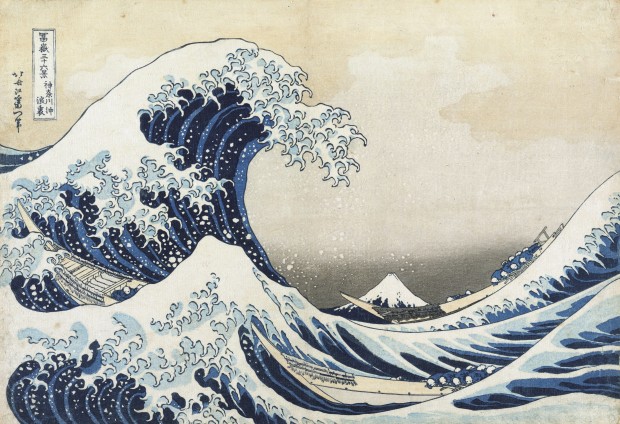The work of Japanese artist, 葛飾北斎 (Katsushika Hokusai, 1760-1849), captured the imagination of foreigners in the late 19th century. Both the subjects of Hokusai’s art and his compositional techniques greatly influenced the history of Western art as well. Below we explore more of his legacy after Hokusai and other works of Japanese 浮世絵 (ukiyo-e, a genre of art from the 17th to 19th century depicting everyday life) took the stage at the 1867 International Exhibition in Paris and influenced many artists of the day.
The immense cultural influence of Hokusai
Hokusai’s impact was not limited to the visual arts. French composer Claude Debussy is said to have conceived “La Mer: Three Symphonic Sketches” from what was then the most famous Japanese work of art in Europe, Hokusai’s 「神奈川沖浪裏」 (“The Great Wave off Kanagawa”) from his series titled 『富嶽三十六景』 (Thirty-six Views of Mount Fuji). The cover of the musical score published in 1905 uses a section of “The Great Wave off Kanagawa.”
 Katsushika Hokusai’s most famous work: “The Great Wave off Kanagawa” from the Thirty-six Views of Mount Fuji series. Photo: Heritage (PPS News Agency)
Katsushika Hokusai’s most famous work: “The Great Wave off Kanagawa” from the Thirty-six Views of Mount Fuji series. Photo: Heritage (PPS News Agency)
Hokusai led Western painting to modernization
Moreover, “The Great Wave off Kanagawa” is believed to have influenced “The Wave” and other works in the series by artist Gustave Courbet. In addition, the painter Henri Rivière is believed to have substituted the Eiffel Tower for Mount Fuji in the Thirty-six Views of Mount Fuji series when he produced lithographs with various depictions of the Eiffel Tower while expressing the composition and deformed expression of Hokusai, including how the iconic tower looked while it was still under construction. He was even called the ukiyo-e artist of Paris.
 “The Great Wave off Kanagawa” even gave birth to a symphony! “La Mer: Three Symphonic Sketches” by Claude Debussy, 1905. Image: akg-images(PPS News Agency)
“The Great Wave off Kanagawa” even gave birth to a symphony! “La Mer: Three Symphonic Sketches” by Claude Debussy, 1905. Image: akg-images(PPS News Agency)
Hokusai’s portrait of a powerful, dynamic wave was a revelation even to musicians. The big wave shown on the cover of the music score may be in homage to “The Great Wave off Kanagawa” from the Thirty-six Views of Mount Fuji, from which the image is taken.
When speaking about Western modern art, it is always mentioned that, “Paris at the end of the 19th century would not have possible without Japonism.” And it was none other than Hokusai who laid the foundation for this.
The impact of Hokusai, who shook the artists of the West, did not stop at the 19th century, but continued to inspire 20th century artists such as Picasso and other contemporary artists. This highly influential Hokusai was a peerless presence whose outstanding accomplishments are now recognized throughout the world.
Year 2014: The largest-ever Hokusai exhibition!
The Hokusai Exhibition commemorating the bicentennial of the publication of the first volume of Hokusai Manga puts Paris into a craze again.
 Photo taken at the Hokusai exhibition at the Galeries Nationales du Grand Palais in Paris held from October 2014 through January 2015. Photo: Reuters (AFLO)
Photo taken at the Hokusai exhibition at the Galeries Nationales du Grand Palais in Paris held from October 2014 through January 2015. Photo: Reuters (AFLO)
The largest-ever Hokusai exhibition in Paris was held in 2014, the 200th anniversary of the publication of the first volume of 『北斎漫画』 (“Hokusai Manga”). The exhibition venue was Galeries Nationales du Grand Palais, which was built as the main hall for the 1900 Paris Expo. Beginning with “The Great Wave off Kanagawa”—Hokusai’s most famous work even among the globally renowned Thirty-six Views of Mount Fuji—some 700 works of art and documents, including 肉筆画 (nikuhitsuga, a genre of brush drawn paintings), rough sketches, and 錦絵 (nishiki-e, polychrome woodblock prints) were exhibited in the 1,000-meter² exhibition hall. Among them were works that have never been displayed in public in Japan.
Hokusai, who, without exaggeration, could be called the father of Japonism and Art Nouveau, is definitely the most famous Japanese artist in the world who enjoys high popularity even in France. Living up to this reputation, long lines formed daily at this exhibition, which Hokusai fans had been looking so forward to seeing. More than 350,000 people attended the exhibition. Not only did it prove that Hokusai’s popularity remains strong in present times, but it also had him gaining new fans and boosting his fame.












